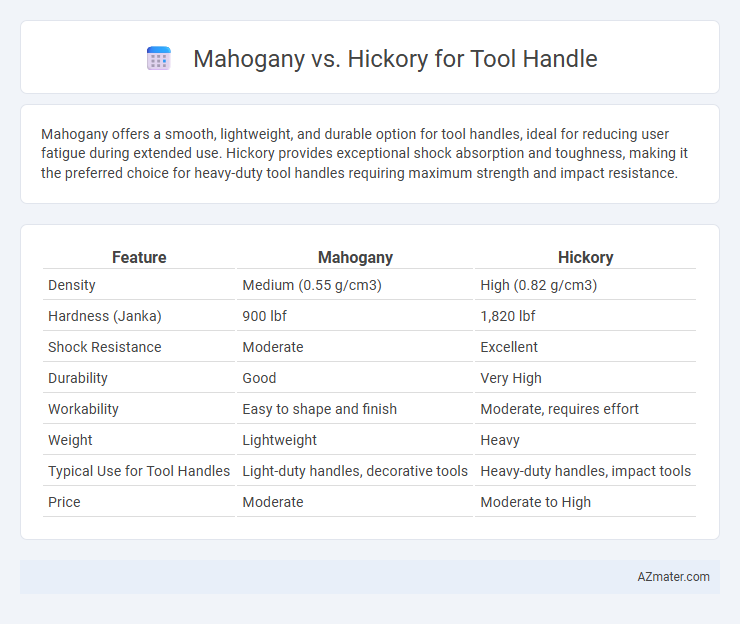Mahogany offers a smooth, lightweight, and durable option for tool handles, ideal for reducing user fatigue during extended use. Hickory provides exceptional shock absorption and toughness, making it the preferred choice for heavy-duty tool handles requiring maximum strength and impact resistance.
Table of Comparison
| Feature | Mahogany | Hickory |
|---|---|---|
| Density | Medium (0.55 g/cm3) | High (0.82 g/cm3) |
| Hardness (Janka) | 900 lbf | 1,820 lbf |
| Shock Resistance | Moderate | Excellent |
| Durability | Good | Very High |
| Workability | Easy to shape and finish | Moderate, requires effort |
| Weight | Lightweight | Heavy |
| Typical Use for Tool Handles | Light-duty handles, decorative tools | Heavy-duty handles, impact tools |
| Price | Moderate | Moderate to High |
Introduction to Mahogany and Hickory Tool Handles
Mahogany tool handles are prized for their smooth texture, durability, and ability to resist moisture, making them ideal for comfortable grip and long-term use. Hickory tool handles are known for exceptional shock absorption, strength, and resilience, often preferred in heavy-duty applications requiring impact resistance. Both woods offer distinct advantages, with mahogany suited for precision tasks and hickory favored for rugged, high-stress tool handling.
Botanical Origins and Wood Properties
Mahogany, derived from the Swietenia genus, is prized for its fine grain, durability, and natural resistance to rot, making it a stable choice for tool handles requiring smooth finishes and moderate impact resistance. Hickory, from the Carya genus, is renowned for its exceptional toughness, shock absorption, and strength, often favored in tool handles subjected to heavy-duty use and repeated stress. The denser grain structure of Hickory provides superior durability, while Mahogany's workability and dimensional stability suit applications where comfort and aesthetics are prioritized.
Strength and Durability Comparison
Mahogany offers moderate strength with excellent shock resistance, making it comfortable for tool handles but less durable under heavy impact compared to hickory. Hickory provides superior strength, exceptional toughness, and high shock absorption, making it the preferred choice for heavy-duty tool handles requiring long-lasting durability. Its dense grain structure resists wear and splitting, ensuring extended service life under strenuous use.
Shock Absorption and Vibration Damping
Mahogany offers superior shock absorption for tool handles due to its dense yet slightly fibrous grain structure, effectively reducing user fatigue during prolonged use. Hickory excels in vibration damping with its high resilience and natural flexibility, making it ideal for tools requiring repeated impact resistance. Selecting between mahogany and hickory depends on whether enhanced shock absorption or optimal vibration control is prioritized for the tool's application.
Weight and Handle Comfort
Mahogany tool handles offer a lightweight feel around 40 lbs per cubic foot, enhancing maneuverability during extended use, while hickory, denser at approximately 50 lbs per cubic foot, provides superior durability and resistance to shock. Hickory's natural flexibility and grain structure contribute to excellent handle comfort by reducing vibrations, favored in heavy-duty tools like axes and hammers. Mahogany handles, though softer, provide a smooth grip but may lack the shock absorbency necessary for prolonged impact tasks.
Workability and Shaping Ease
Mahogany offers excellent workability due to its straight grain and moderate density, allowing for smooth shaping and sanding with minimal effort. Hickory, known for its exceptional toughness and density, presents more challenges in shaping but provides superior durability for heavy-duty tool handles. Woodworkers often prefer mahogany for intricate designs, while hickory serves better in applications requiring high impact resistance.
Resistance to Wear and Environmental Factors
Mahogany offers moderate resistance to wear and performs well against moisture, making it suitable for tool handles exposed to humidity. Hickory excels in wear resistance due to its high density and shock-absorbing properties, providing durable performance under heavy use and impact. Hickory also demonstrates superior resistance to environmental factors such as temperature fluctuations and abrasion, making it a preferred choice for rugged, long-lasting tool handles.
Cost and Availability
Mahogany tool handles tend to be more expensive due to their premium quality and limited supply, often sourced from tropical regions, making them less readily available. Hickory, by contrast, is widely available in North America and offers a lower cost option while maintaining excellent durability and shock resistance. The abundant supply of hickory contributes to its affordability, making it a preferred choice for cost-effective, reliable tool handles.
Best Applications for Each Wood Type
Mahogany offers a smooth, lightweight feel and excellent shock resistance, making it ideal for precision tools and fine woodworking handles. Hickory provides superior strength, durability, and impact resistance, perfect for heavy-duty tool handles like hammers, axes, and mallets. Choosing mahogany enhances comfort during extended use, while hickory excels in applications requiring maximum toughness and wear resistance.
Final Verdict: Choosing the Right Wood for Your Tool Handle
Mahogany offers a smooth grain and moderate durability, making it ideal for tool handles that require a comfortable grip and aesthetic appeal. Hickory, known for its exceptional strength, shock resistance, and durability, is the preferred choice for high-impact tools like axes and hammers. Selecting between mahogany and hickory depends on the required toughness and comfort, with hickory being optimal for heavy-duty use and mahogany suitable for lighter, more ergonomic handles.

Infographic: Mahogany vs Hickory for Tool Handle
 azmater.com
azmater.com